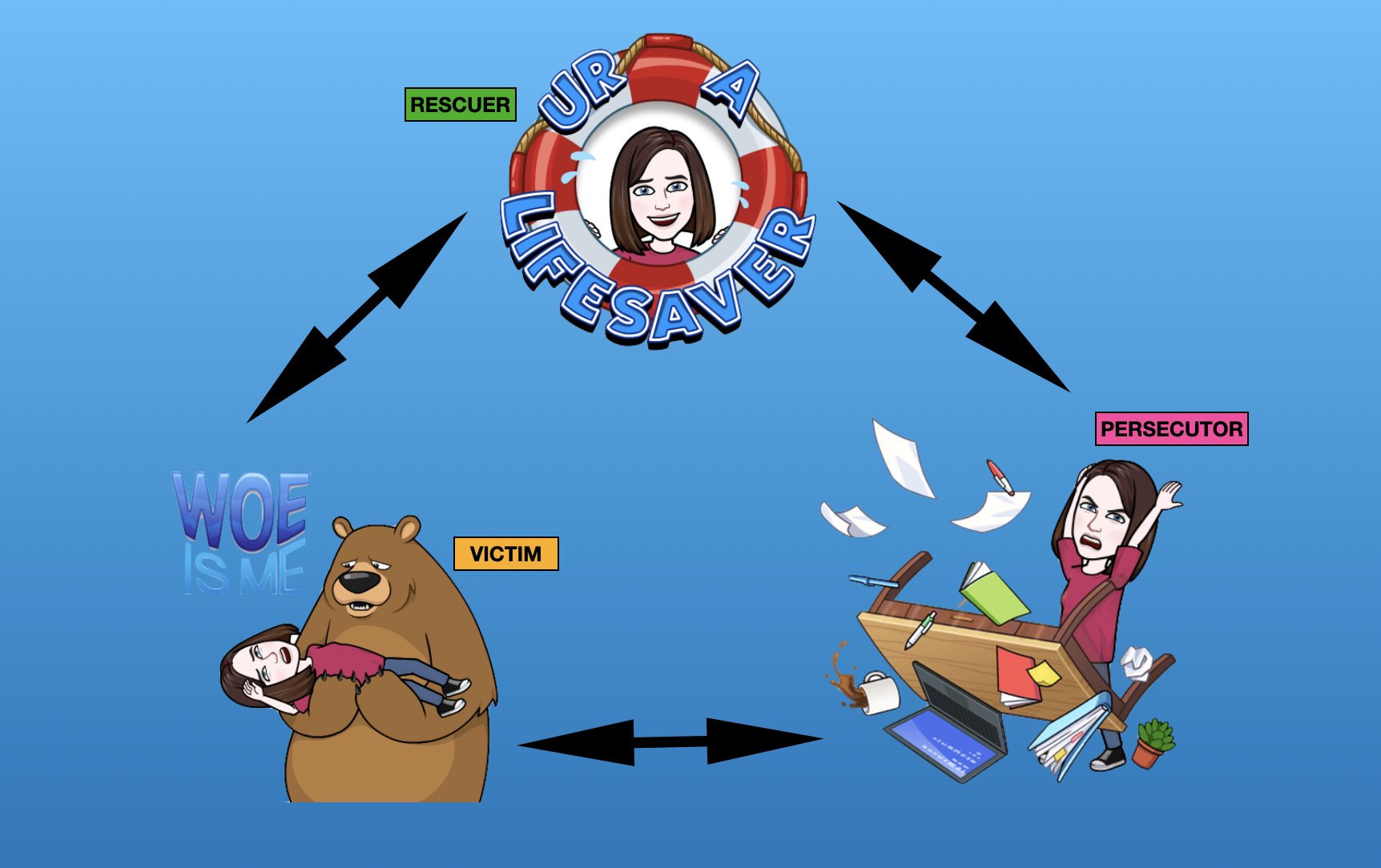Watching People Talk - Drama Triangle at Work
Words are powerful. The way we speak to each other shapes how we feel, how we work, and even how we see ourselves. In a team setting communication can build trust or quietly break it down. Sometimes without even knowing it, we fall into roles in conversations that create drama, confusion, or stress. One of the most useful tools to understand this pattern is the Drama Triangle.
⚠️ what is the drama triangle
The Drama Triangle was developed by Dr. Stephen Karpman in the 1960s. It is a model of dysfunctional social interaction. In this triangle, people take on one of three roles:
Victim - feels helpless, stuck, or unfairly treated
Persecutor - criticizes, blames, or controls
Rescuer - jumps in to "save" others, often without being asked
These roles can shift quickly during a conversation. One moment you feel like a helper, and the next you are being blamed, or you are blaming someone else. This triangle creates drama instead of solving problems.
🧐not manipulation, it’s a habit
The Drama Triangle is not something we consciously choose to play. Most of the time we slip into these roles unintentionally, driven by stress, emotional patterns, or unmet needs. It is usually a subconscious reaction, not deliberate manipulation.
We might jump in as the Rescuer because we want to be helpful, but we may unintentionally disempower others. Or we might take on the Victim role because we feel unheard or overwhelmed - not because we want pity. The Persecutor role can show up when we feel frustrated and try to take control, even if it means blaming others.
These roles can switch quickly within a single conversation. Someone might start off as a Rescuer, then feel unappreciated and become the Victim, and later respond with blame, slipping into the Persecutor role. It is a cycle that creates emotional noise instead of clarity and connection.
🧠 why it matters at work
In teams this unconscious pattern can show up during project discussions, code reviews, hiring conversations, or feedback sessions. It leads to misunderstandings, defensiveness, and strained relationships, even when everyone has good intentions.
By becoming aware of the Drama Triangle, we can start recognizing when we are sliding into one of the roles and pause before reacting. This gives us a chance to step out of the triangle and respond more constructively with curiosity, ownership, and empathy.

👀 what does drama triangle can look like at work?
The drama triangle can sneak into even the most well-meaning teams. It does not always sound dramatic or toxic. Often it is subtle. It hides behind frustrated questions, over-helping, or quietly taking on too much without speaking up. Below you can find a few common workplace scenarios where the drama triangle quietly takes the lead and how it affects collaboration without us even noticing.
Example 1: Project manager & developer
PM: “This feature is still not done? We can’t afford more delays.” (Persecutor)
Developer: “I’m doing my best, but priorities keep changing.” (Victim)
PM: “Let me help you break it down so we can speed it up.” (Rescuer)
👉 What’s missing? Clear ownership and honest conversation about scope, priorities, and planning. Each role reinforces tension rather than solving the real problem.
Example 2: QA engineer & developer
QA: “There are still bugs in this release. Can you finally fix them?” (Persecutor)
Dev: “I didn’t even know about those! Why does this always fall on me?” (Victim)
QA: “Okay, I’ll log them again and try to verify myself.” (Rescuer)
👉 The dynamic turns into blame and overwork, instead of teaming up on process improvements or clearer communication.
Example 3: Hiring manager & Recruiter
Recruiter: “I’ve reached out to over 50 candidates, but very few responded positively.” (Victim)
Manager: “Maybe we are being too picky. Let me look through the profiles myself.” (Rescuer)
Recruiter: “I’m trying everything I can here.” (Victim, again)
👉 Instead of a collaborative review of the sourcing strategy or refining the job ad, the triangle creates tension and subtle undermining.
Example 4: Boss & CTO
Boss: “Why is our delivery speed slowing down?” (Persecutor)
CTO: “We are doing what we can with the team size we have.” (Victim)
Boss: “Maybe I should personally join the sprint planning next week.” (Rescuer)
👉 Rather than addressing root causes like resource planning or technical debt, the conversation spirals into stress and overstepping.
Example 5: Marketing specialist & Manager
Manager: “Why aren’t we seeing better engagement on this campaign?” (Persecutor)
Specialist: “We tried everything, but the algorithm keeps changing.” (Victim)
Manager: “Let me rewrite the ad copy myself.” (Rescuer)
👉 This erodes trust, motivation, and learning opportunities. The triangle turns creative teamwork into subtle blame and micromanagement.
🚩the drama triangle in feedback processing
Feedback is another place where the triangle often shows up especially when emotions run high.
- Someone receiving feedback might feel attacked (Victim).
- The giver might come across as blaming (Persecutor).
- A third person might jump in to smooth things over (Rescuer), instead of helping both sides process and grow.
That is why building a healthy feedback culture requires more than just “giving feedback.” It means being aware of these subtle emotional patterns, staying curious instead of reactive, and focusing on shared goals instead of playing roles.
🆘 how to step out of the drama triangle - reframing roles
Just becoming aware of the drama triangle is already a powerful first step. Once you notice the patterns, you can choose a different way to respond - one that leads to clarity instead of confusion, ownership instead of blame.
Building on Karpman’s work David Emerald offers a powerful alternative in his book The Power of TED. He reframes these three roles into more positive, empowering ones that help break the cycle of drama. Instead of the Victim we become the Creator - taking responsibility and focusing on solutions. The Persecutor becomes the Challenger, who provides honest, constructive feedback without blame. And the Rescuer evolves into the Coach, supporting others to find their own answers rather than taking over. By adopting these new roles we can shift out of the drama roles and run into constructive collaboration:
✅ From Victim to Owner
Instead of thinking “This is happening to me”, shift to “What can I influence or ask for?” Ask yourself:
- What do I need right now to move forward?
- Is there a request I can make instead of just expressing frustration?
- Am I taking responsibility for what is actually mine (and not more than that)?
💬 Instead of: “There’s nothing I can do.” Try: “Here’s where I am stuck, and here is what would help.”
✅ From Persecutor to Challenger
Instead of blaming, challenge others constructively and stay solution-oriented. Ask yourself:
- Am I criticizing, or am I helping someone grow?
- Am I assuming negative intent, or staying curious?
- Can I be direct and respectful?
💬 Instead of: “Why haven’t you done this yet?” Try: “What’s blocking progress on this? How can we solve it?”
✅ From Rescuer to Coach or Partner
Instead of fixing things for others, empower them to solve it themselves (with support if needed). Ask yourself:
- Am I helping, or taking over?
- Has this person asked for help, or am I jumping in by habit?
- Can I offer support without removing ownership?
💬 Instead of: “I’ll take care of it for you.” Try: “How can I support you in figuring this out?”
Teams can also create shared practices to make drama less likely. For example, we can normalize asking questions before assuming intent and create psychological safety where people can admit mistakes without blame. Also making “ownership” part of your culture and knowing who is responsible for what really help. And last but not least - honest daily communication - use check-ins to surface emotions early instead of letting them leak into conflict.
final thoughts
The Drama Triangle isn not about bad people or broken teams. It is about human habits we all fall into, especially under pressure. It is natural. But when we notice it, we can shift. Instead of blaming, we can ask. Instead of rescuing, we can support. Instead of feeling like a victim, we can take ownership. The key is not to avoid emotion, but to notice the pattern and step out of the drama with intention and kindness.
Language shapes our world. And every time we choose a healthier way to speak, we help build a better one. ❤️
